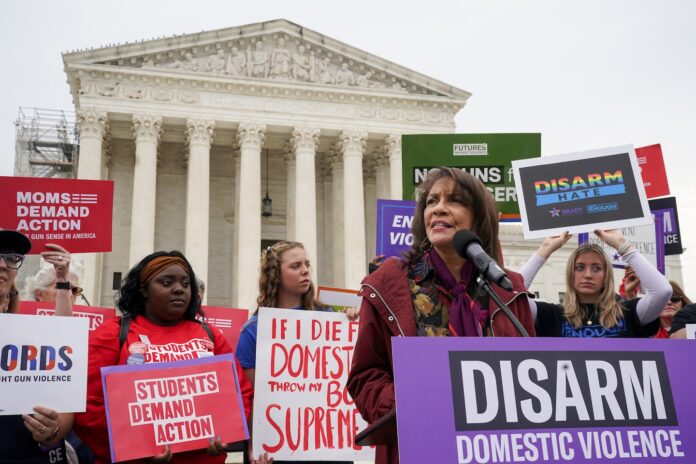In an 8-1 ruling, Chief Justice John G. Roberts Jr. said that “when a restraining order contains a finding that an individual poses a credible threat to the physical safety of an intimate partner, that individual may—consistent with the Second Amendment—be banned from possessing firearms while that order is in effect.”
Even as the justices overwhelmingly upheld gun restrictions for domestic abusers, however, five of them chose to write separately from Roberts, suggesting they hold differing views for how lower courts should evaluate and consider historical practices when reviewing Second Amendment challenges to other gun-related laws.
“Some courts have misunderstood the methodology of our recent Second Amendment cases,” Roberts wrote. “These precedents were not meant to suggest a law trapped in amber.”
The court left for another day more difficult questions about the viability of other gun-control measures, such as laws banning military-style semi-automatic rifles and large-capacity magazines.
The 2022 Bruen decision required the government for the first time to point to historic analogues when defending laws that place limits on firearms. That ruling has led to a spate of court challenges against limits on gun possession, including the one in this case, United States v. Rahimi.
Justice Clarence Thomas, who authored the Bruen decision, was the lone dissenter on Friday, writing that “not a single historical regulation justifies the statute at issue.”
Attorney General Merrick B. Garland praised the court’s decision, saying the law “protects victims” by keeping guns out of the hands of people who threaten them.
“As the Justice Department argued, and as the Court reaffirmed today, that commonsense prohibition is entirely consistent with the Court’s precedent and the text and history of the Second Amendment,” Garland said in a statement.
The challenge to the law was brought by Zackey Rahimi, a drug dealer who was placed under a restraining order after a 2019 argument with his girlfriend. He argued that the government had violated his Second Amendment rights by blocking him from possessing guns.
Rahimi knocked the woman to the ground in a parking lot, dragged her back to his car and fired a shot at a bystander, according to court records. The girlfriend escaped, but Rahimi later called her and threatened to shoot her if she told anyone about the assault. The pair have a child together.
A Texas court found that Rahimi had “committed family violence” and that such violence was “likely to occur again in the future.” It issued a protective order that suspended Rahimi’s gun license, prohibited him from having guns and warned him that possessing a firearm while the order remained in effect might be a federal felony.
Rahimi later violated the protective order and was involved in five shootings between December 2020 and January 2021, according to a government brief.
In early 2021, Rahimi was arrested at his Texas home, and police found “a .45-caliber pistol, a .308-caliber rifle, magazines, ammunition, and a copy of the protective order,” the government said in its brief. He was charged with illegally possessing a weapon since he had a restraining order against him.
Rahimi argued in federal court that he had the right to possess guns, but a judge ruled against him on that issue. Afterward, he pleaded guilty to the federal charge and received a sentence of six years in prison. He continued to challenge the law, and the U.S. Court of Appeals for the 5th Circuit reheard his case after the Supreme Court’s Bruen ruling.
Bruen struck down a New York law barring law-abiding citizens from carrying guns outside the home for self-defense. In that opinion, Thomas established a new test for gun laws: restrictions on ownership must have a parallel in American history. The decision has endangered all types of gun regulations and left lower court judges divided over how to evaluate long-standing restrictions, in some cases asking whether they should call on historians to help.
A unanimous 5th Circuit panel found that Rahimi was among those whose right to a weapon is protected by the Second Amendment. It rejected the historical comparisons that the government offered to justify the law barring those with protective orders from possessing guns.
Gun-control advocates and groups representing victims of domestic violence praised the court Friday for reversing the 5th Circuit.
The Supreme Court “rightly refused to end a common-sense safety measure that has been making our families and communities safer for decades,” Esta Soler, president of the non-profit Futures Without Violence, said in a statement.
Last week, the Supreme Court ruled against the federal government in a different gun rights case, overturning the federal ban on bump stocks announced by the Trump administration after the devices were used in a 2017 mass shooting on the Las Vegas Strip.
The devices allow guns to fire bullets in rapid succession. In its 6-3 ruling, the majority said bump stocks do not qualify as machine guns under a 1986 law that barred civilians from owning new versions of the weapons.
This is a developing story. It will be updated. Mark Berman and Justin Jouvenal contributed to this report.



